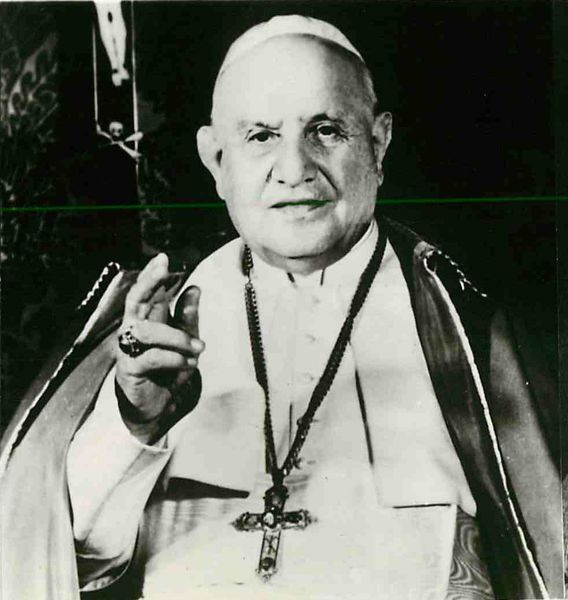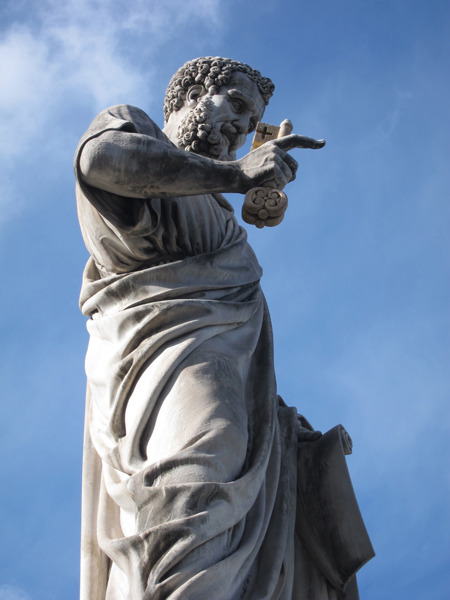(RNS) When Pope Francis canonizes Popes John XXIII and John Paul II on Sunday (April 27), Catholics across the spectrum will have reason to cheer: Liberals credit John with opening the church to the modern world in the 1960s, and conservatives hail John Paul as reasserting orthodoxy after too many innovations.
But the unprecedented double-barreled canonization also raises a question that might give both sides pause: Why is Rome making saints of almost every modern pontiff after nearly a millennium when almost no popes were canonized?
- SIDEBAR: Everything you need to know about popes and saints (RNS)
In the first 500 years of Christianity, the Apostle Peter (considered the first pope by tradition) and 47 of his 48 papal successors were viewed as saints, mainly because so many of them were martyred, which is the simplest route to canonization. Another 30 popes were named saints in the next 500 years, largely based on their reputation for sanctity.
But as Kean University’s Christopher Bellitto notes, in the next nine centuries, just three popes became saints. That relative drought ended only in 1954 when Pius X was canonized, 40 years after his death.
“If you do have the option of canonizing popes, perhaps their waiting period should be quite long — 50 or even 100 years before starting, with no possibility at all of waiving the delay,” said Bellitto, a church historian, who supports a moratorium on all papal canonizations.
The dual canonizations have prompted criticisms that are unusually pointed for prospective saints — and especially for two popes who are generally remembered so fondly.
Soon after his death in 2005, John Paul was being hailed as “John Paul the Great,” an honorific given to just two or three other popes in history. And at his funeral, many in the massive crowds held signs demanding “Santo Subito!” or “Sainthood Now!”

With his new 25,000-word encyclical, “Mater et Magistra,” Pope John XXIII has joined two other pontiffs whose encyclicals on social problems constitute the greatest documents of their kind in the modern history of the church. Religion News Service file photo
A little more than a month later, Pope Benedict XVI responded to the outpouring by waiving the standard five-year waiting period before launching a cause for canonization.
Yet in recent years, John Paul’s problematic record on the clergy sex abuse scandal has tainted his legacy; on Tuesday (April 22) Vatican officials were forced to defend him during a press conference that was supposed to celebrate the two popes.
- READ: The legacies of John Paul II and John XXIII (RNS)
At the same time, some conservatives are upset that “Good Pope John,” as John XXIII is widely known, is being pushed to sainthood along with John Paul, because they say John’s legacy of reform gravely undermined Catholicism.
“It is impossible to speak of sanctity for him,” Roberto de Mattei, a professor of church history at the European University in Rome and a favorite of the Catholic right, said recently.
Now, almost every pope in the modern era — starting with Pius IX, the ultra-traditionalist pontiff of the 19th century, and running up through Pius XII (who died in 1958), Paul VI and John Paul I (who reigned for just 33 days in 1978) -– is in the canonization pipeline.
What accounts for this sainthood surge?
Experts cite a combination of factors. For one, more recent popes have arguably been holy men rather than monarchs, and they look especially good in comparison to the various rogues and warriors who occupied the papal throne in the Renaissance era.
“In a sense they are witnesses of a Christian life,” said Massimo Faggioli, a theologian at the University of St. Thomas in Minnesota and author of a new biography of John XXIII.
Modern popes, Faggioli said, “are less subject to the political and social constraints of established European Catholicism, when to become pope you had to be part of the right family or alliance, and being violent or ruthless or almost a war criminal had no importance.”
Today, he said, popes are expected to be saints more than rulers, pastors of a church “that tries to be closer to the gospel than to the Roman Empire.”
Another factor: John Paul II was devoted to saints, and he canonized 482 men and women during his 27-year reign, far more than the approximately 300 saints that popes had canonized in the previous six centuries combined.

Pope John Paul II, the former Cardinal Karol Wojtyla of Poland, was enthroned on Oct. 22, 1978. Religion News Service file photo
Critics accused John Paul of turning the Vatican into a “saint-making factory,” while others said he was simply democratizing the system. Either way, several popes were beneficiaries of the expansion, including now John Paul himself.
But a major reason for the shift is that since the 19th century, popes have become central to Catholic identity in a way that they had not been before. They are both symbols of the faith to the wider world and standard-bearers of one cause or another within the church.
The problem, however, is that the drive to make all popes saints means that the process can look political. It also runs the risk of focusing on pontiffs and overlooking other candidates who would be widely accepted as saints — Mother Teresa, for example, who appears stuck at the beatification stage.
“Do we put the shine of canonization on only those aspects of a pope’s life that we like but say it doesn’t apply to those we don’t like? And who makes that call?” Bellitto said. “It takes cafeteria Catholicism all along the ideological spectrum to a whole new level.”
Moreover, the process can come off as a kind of holy logrolling in which sitting popes canonize their predecessors in expectation that they, too, will be canonized. Benedict XVI — who can’t be up for sainthood because he’s still alive — jump-started the canonization of John Paul, who he worked with for more than 23 years.
In the end, the trend could actually backfire if the public assumes that every pontificate comes with an automatic — or at least expected — halo.
“Now most of the saints are ‘fast food saints’ and they are quickly forgotten,” Faggioli said. “We will see if these pope-saints will be forgotten, too.”
KRE/AMB END GIBSON







